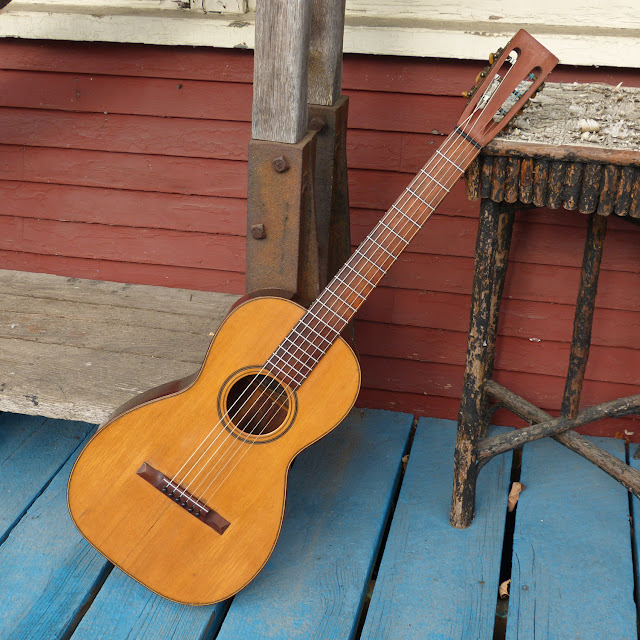1890s Haynes-made Bay State Style H Parlor Guitar
This guitar has been ages in the workshop. Its owner has been, thankfully, very patient! Its serial number places it in the late 1890s and it's a Bay State "Style H" -- with slightly fancier appointments than usual and rosewood back and sides. It's a gorgeous-looking and gorgeous-sounding instrument and built with quality and attention to detail throughout.
Specs-wise it's in the realm of a period Martin size 2 with a 12 1/8" lower bout width, wide-ish 1 13/16" nut, and 24 3/4" scale length. Its wide nut doesn't imply clunky handling, though, as the fretboard has a radius close to 12" and the neck has a very mild depth and a sharp V-shape which means it's quite fast. The top is spruce and ladder-braced, the back and sides are Brazilian rosewood, the neck is mahogany, and the bridge and fretboard are rosewood as well.
Work included quite a bit -- several hairline crack cleats were added to the top, many braces were reglued, seams were reglued along the back edges, and a giant crack that was sort-of-repaired in the past needed to be re-repaired. I also gave it a neck reset, a fret level/dress, reglued the bridge, and added a slightly-taller new fret saddle and ebony pins.
The results are worth the work, however, and as you can hear in the soundclip this thing has a lovely tone that suits fingerpicking (and light flatpicking) really well.
The nut is original ebony.
You can see some of my added side-dots in these pics.
The strings are John Pearse JP116s -- a Thomastik-made product that's a slight variation on Thomastik KR116s which are rope-core steel classical hybrid sets. They sound wonderful with these old gut-strung (originally) guitars as they have a "gut" bass-voice and a more "steel" treble voice which makes the guitars a lot more approachable for your average folk guitarist.
This came with a bridge that was totally gobbledy-gooked with glue all over the place -- both on the bridge and the top itself. It was a pain to clean it all but I got it all off, filled the old pinholes, and reglued this sucker nice and pat.
Note the small missing bits of rosewood from the front edges of the "wings" -- it was like this when it came in. This bridge also has the cool "sanded-down" pyramid touches on the wings.
Though the back is unbound, that rosewood hardly needs any dressing-up!
The neck joints on these are a 1/8" deep tenon type. When I reset these, steam them out and then shim them back a little and glue them up but also double-bolt them from the inside at the same time. There's no way I'd trust a joint like this with glue alone.
This big long side crack is kinda gross but it is now stable. After regluing it, I backed it with glue-soaked cloth (rather than a million cleats) just like they might've done "in the old days." Hopefully this will keep it tidy for a long while.
The crack terminates just aft of an original "glue-soaked-cloth" reinforcement strip. It just goes to show how effective those factory additions were at keeping stuff like this at bay.





















Comments